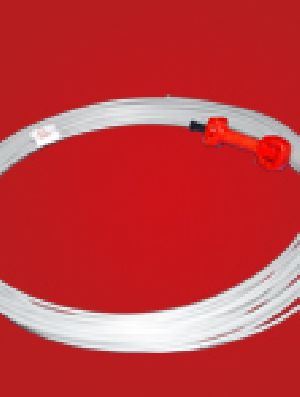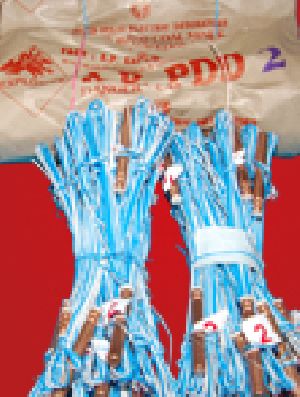
non-electric initiating devices
APEXCEL TLDs are non-electric initiating devices used for surface initiation in blasts to provide necessary delay between the holes in rows and between the rows. APEXCEL TLD consists of a shock tube with a delay detonator with a suitable bunch connector at one end and the other end is sealed. The bunch connector has the provision to hold six tubes for initiation. The bunch connectors are colour coded to indicate the delay timings. Delay Timings Colour Code Instantaneous Blue 17ms Yellow 25ms Red 42ms White 65ms Green Advantages 1. Surface air blast is completely eliminated.2. Use of detonating cord or cord relays is eliminated3. The bunch connectors are user friendly and allow for easy on-site connection for the blast4. They provide accurate delay per hole by improving muck file profile and thereby increase the fragmentation and overall blast performance.
...more
Permitted Delay Detonators
APPDD are available in 0-6 numbers with delay interval of 25milliseconds. The shells are made of copper material. The delay element is inserted above the primary charge and consolidated. The delay timing is achieved by the lead element on the primary charge. The two lead wires are passed through the PVC plug soldered with the fuse head and crimped. Application Permitted delay detonators are used in gassy underground coal mines.
Shell Material : Copper
...more
Instantaneous Electric Detonators
Instantaneous electric detonators comprise aluminium shells which are crimped with an electric fuse head soldered to a pair of GI wire having required PVC plug with APEL embossed on the plug for identification of the manufacturer. Each fuse head is checked for electrical characteristic like resistance that provides high reliable initiation of the explosives. The bare wires at the other end of the detonators are shorted with the body of the shell to arrest from initiation due to stray or static currents. After arranging instantaneous electric detonators in series, they are fired by means of blasting machines which gives adequate amount of energy required in the form of electrical impulse Application Instantaneous electric detonators are initiators which have a wide range of applications in open cast, quarrying and also non-gassy underground mines, construction sites etc. Packing Instantaneous Electric detonators are made into bundles of 25 numbers. Two such bundles are then wrapped in craft paper to make a packet of 50 detonators. Thirty such packets are placed in a corrugated fiberboard box. The quantity per box may vary depending on the length of the wire used.
Shell Material : Aluminum
Net Weight : 14.5 kgs
...more
Instantaneous Copper Electric Detonator
Copper electric detonators comprise copper shells filled with PETN and ASA as base and primary charge respectively. These shells are crimped with a pair of PVC coated wires soldered to fuse heads. The two lead wires are passed through PVC plugs of required length and diameter to protect from moisture and water. The other end of the wire is shorted to the detonator to protect against any stray/static current. Application CEDs are used for initiation of explosive charges with controlled blasting which are used in underground gassy coal mines. CEDs are arranged in series. The firing is carried out by using an exploder which gives the required energy in the form of an electric impulse. Packing 25 detonators are crimped and formed into a bundle. Two such bundles are wrapped in craft paper to make a packet of 50 nos. As per the length of the wire, the packets are kept in a corrugated box
Shell Material : Copper
...more
electric detonator
Copper electric detonators comprise copper shells filled with PETN and ASA as base and primary charge respectively. These shells are crimped with a pair of PVC coated wires soldered to fuse heads. The two lead wires are passed through PVC plugs of required length and diameter to protect from moisture and water. The other end of the wire is shorted to the detonator to protect against any straystatic current.
...more
Down the Hole Detonators
DTH detonators are developed to provide accurate down the hole-delay in the blast. It consists of a shock tube of required length, with delay detonator and a suitable connector. In order to arrest the ingress of water, the connector end is sealed. The other end of the tube is crimped to a delay detonator with a suitable plug. Application These are used for surface blasting, quarrying and long hole-blasting. Advantages 1. True bottom initiation is achieved2. Ground vibration is controlled3. Air blast noise is minimized4. Good fragmentation5. As the explosive shock wave is confined, there is no desensitization of explosives. This results in higher explosive efficiency.6. Risk of accidental initiation due to stray current, static charges and radio frequency signals is ruled out.
Strength : No. 8
...more
cord relay
AP Explosives manufactures cord relays. Cord relays provide accurate delay between blast holes in a row or cross in a multiple row blast. Cord relays are of 2ms delay detonators of the same delay timing placed in opposite direction specifically designed plastic component. Cord relays are bi-directional. The plastic component has a provision for hooking of detonating cord at either ends. The delay timings are printed on the plastic component. Application These are used in conjunction with detonating cord trunk lines in open casts, coal mines, quarrying, civil construction, underground metal mines. Advantages 1. Being non-electrical, they are immune to electricity sources such as stray current, static electricity and radio frequency energies.2. They are simple to use and bi-directional3. The hook for the detonating cord provides two to three surface detonating patches, thus reducing the misfire risk.4. Initiation is sequential reducing the problem of overlap5. Since each delay can be controlled by using different delay intervals, there is lesser vibration Cord Relays are available in intervals of 17 ms, 25 ms, 42 ms, 50 ms, 65 ms, 100 ms, etc.
...more
AP Special Ordinary detonators
APSODs are used in conjunction with safety fuses. The spit of fire from the safety fuse initiates the ASA charge which then detonates the PETN charge. This in turn will initiate the ANFO or cartridge explosives. Application APSODs in conjunction with safety fuses are based on non-electric initiation by nature and are used widely as a safe alternative in dry as well as moist locations and in non-gassy underground mines. They are used in open cast blasting applications/non-gassy mining, road construction, surface excavation, stone and metal quarrying. Packing Special ordinary detonators 100 numbers are first packed in a paper carton. 5 such cartons are wrapped in a craft paper. Twenty such packets are placed in a double walled wooden case with bitumen liner inside. The case is then marked with important details such as manufacturer’s name, date of manufacturing, quantity, net weight, gross weight and batch number.
Outer Diameter : 7+/- 0.02 mm
Strength : No.8
...moreBe first to Rate
Rate ThisOpening Hours